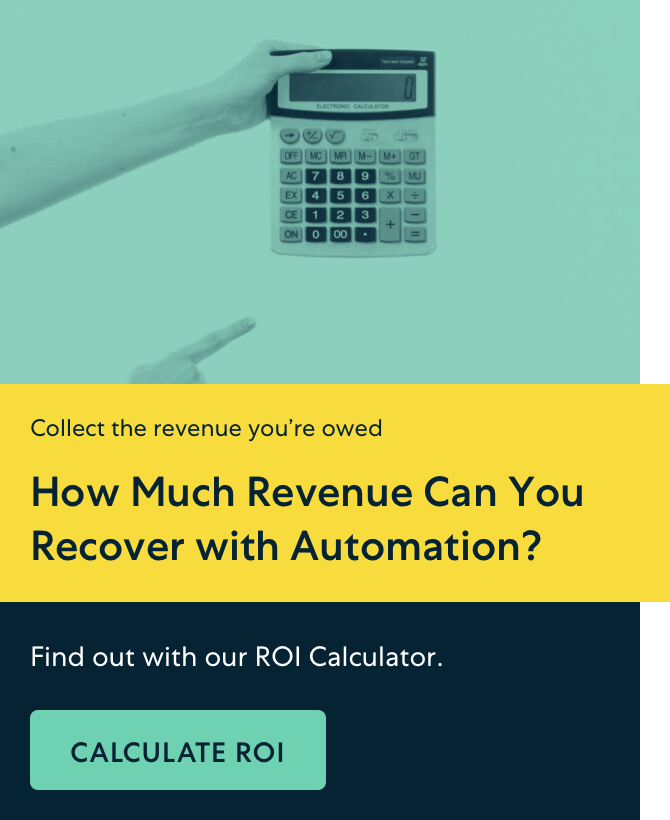Since you’re here, you’ve probably already heard about the plentiful benefits of a fully automated billing system.
So far, you’re impressed by this intriguing platform. You’ve read about how it sends invoices, applies late fees and other charges or discounts, helps you get paid faster, improves customer satisfaction, and collects real-time data on metrics like churn and acquisition rates.
The bells and whistles sound great. Brilliant, even! It runs circles around your current manual billing process or existing accounting software. But, let’s be frank. It’s the cold, hard cash that you really want to hear about.
This brings us to the question…
Are automated billing systems a worthwhile investment? And how many dollars can they really help you save?
I want to demonstrate why such platforms are beneficial—especially in the software as a service (SaaS) industry for those with rapid growth plans. So, I’ve calculated average monthly savings based on a mid-market SaaS business.
Let’s assume the business in question makes $5 million in annual recurring revenue (ARR) with around 100 customers.
Discover 5 key benefits of using recurring billing automation to save both time and money.
Automated billing systems help with subscription management in a myriad of ways. I’ve identified 5 key areas—billing, dunning and collections, tax, data entry, and revenue recognition (rev rec)—that will benefit financially when you automate processes with the right billing software.
1. Billing and invoicing
The recurring billing model requires frequent invoicing, sometimes for variable amounts. Add multiple subscription options, usage-based plans, and mid-cycle plan upgrades, downgrades, and cancelations to the mix, and you’ve got a seriously complex billing system on your hands.
Often, a business starts out using basic billing software or, God forbid, spreadsheets to manage its intricate invoicing and billing processes.
*Screams*
Not only does this leave a huge potential margin for human error, but it can also be highly time-intensive and a roadblock to growth.
Using an automated billing system designed for recurring billing at scale:
- eliminates the risk of costly human mistakes,
- saves time and resources,
- ensures customers always receive clean, accurate, and branded statements and invoices,
- acts as a single source of truth (SSOT) for customer data and documents like invoices,
- enables multiple departments to answer customer inquiries confidently and efficiently, and
- lets you see projected invoicing information for better business forecasting.
This contributes to a better customer experience and improved scalability—which is all very well and good, but what does it mean for your bottom line?
Reduce your monthly expenses by $800 to $5500+ by automating your invoicing process
We’ve seen as much as a 90% reduction in billing time, but pretty commonly we see businesses free up around 40 hours a month.
Take JustLogin for example, a leading cloud-based HR software solutions provider in Singapore. Billing its 800 customers manually used to take up to three team members two whole weeks, including overtime. Ouch.
Since introducing an effective automated billing system, its billing and invoicing process has been reduced by 90%, to just a few hours!
Let’s translate that to a dollar amount. Say a typical work week is 40 hours, plus 8 hours of overtime. The average salary for billing clerks in Singapore is just over 27 Singapore Dollars (SGD) per hour. This roughly equates to 19.50 US Dollars which is well within the average range for US-based billing clerks.
That’s a saving of over $5500 (USD) on salaries alone. And that’s not to mention the savings on revenue leakage from forgotten invoices and time spent dealing with billing mistakes.
“Our business has scaled up three times, but we are actually spending less time on billing and more time on the proactive side of the company’s expansion,” says JustLogin’s COO, Chiou Hao Chan.
2. Dunning and collections
Generating invoices and sending them to customers is pointless if they’re not going to get paid. This is why dunning management and payment collections are so important.
Collections activities like following up on overdue invoices for late payments, sending notices to update cards on file, and retrying payments after failed transactions are almost as time-consuming as billing and invoicing.
An automated billing system should have features like credit card auto-updating, automated dunning emails, and automated collection re-attempts to take the work off the plates of your accounts receivable (AR) team.
Automate dunning and collections to save between $8,333 and $41,666
Most subscription-based B2B businesses see a 6-26% payment failure rate, the lower end being for monthly rebills, and the higher end for annual.
This doesn’t include the dollar value of the time spent. However, automating payment collections activities commonly helps businesses put between 2% to 4% of monthly revenue back on their bottom line. Backend as a service (BaaS) provider bitHeads began recovering between 5% and 10% each month after adding automation to its dunning process!
3. Tax calculations
Ah, tax! One of life’s famous few certainties. And if your business serves customers in multiple countries, probably the source of a few headaches. Even taxes in the U.S. can seem like they’re designed to trip you up, like how different zip codes have different tax rates.
For some businesses like CoConstruct, calculating basic taxes at the state level wasn’t enough. CoConstruct needed to get more granular and it was commanding tens of hours of manual work each month. Aside from the time and effort involved, human error in tax calculations was causing the business to leak thousands of dollars every month.
Automated billing software makes handling complicated taxation requirements as easy as pie. It can automatically apply changes to taxability rates and rules, track and account for exceptions, and take care of other tax-related tasks that would otherwise eat into your team’s precious time.
So how much money will it save your business?
Given how wildly taxation may vary between businesses, it’s tricky to pinpoint the amount manual taxing calculation costs you. But we can look to real-life examples for guidance. In the case of CoConstruct, the business began putting $2,000 back on its bottom line every month after switching to an automated billing solution.
4. Data entry
Your tech stack includes vital elements—like your CRM, ERP, accounting software, and payment gateway—that need to communicate with each other for optimal efficiency. When your automated billing system integrates with these systems, it allows you to:
- move revenue between earned and deferred ledgers,
- update key reports and financial statements,
- get insight on various aspects contributing to RevOps efficacy,
- better measure key metrics indicating overall business health like customer lifetime value,
- accurately sync customer information between the CRM, ERP, and billing software, and
- reconcile and compile invoices and post payments.
Hello, data integrity! Something you’ll be mighty thankful for if the IRS come a-knockin’ on your door—but that’s not all. An automated billing system will free up your talented accounting staff to focus on more value-producing projects and strategic growth initiatives. Which equates to…
Money, money, money
Based on average salary data and assuming a daily time-saving effect of one hour, your business can save at least $560 per month.
Let’s consider the average manual data entry error rate of about 1%. How many hundreds or thousands of fields of data are your staff entering per day? How many times do they move or copy that information to another system or use it in a further calculation?
Now let’s apply the $1-$10-$100 rule. It says that it costs roughly $1 to verify data accuracy at the point of entry, $10 to clean it up (in batch form), and $100 or more if it goes unrecognized or undealt with in the longer term.
It’s not unusual for a SaaS business to generate well over a million journal entries per month. That means errors could easily be costing your business $10,000, or in a worst-case scenario, that number could be as high as $1 million…or more.
5. Revenue recognition
It’s nearly impossible to be compliant with ACS 606 without using automated billing software. The recent update requires you to recognize revenue when the goods or services are delivered, i.e. performance obligations are met, rather than at the initial time of sale.
This is especially complex for subscription billing services as revenue from each customer is often deferred over many months and may not be distributed evenly.
An automated billing system saves you money in IRS penalties and keeps your ledgers clean, detailed, and accurate. This allows your finance team to easily track earned and deferred revenue and plugs any leakage from things like inaccurate refunds.
So how much are we talkin’?
When B2B SaaS company Uberflip switched to an automated billing system to manage revenue recognition and streamline operations, it saved more than 40 hours per month, or roughly $1,120 in employee wages, going by average salary data for US accountants.
Improper revenue recognition can lead to financial reports that show more or less profit than is actually true. This can affect monthly and annual targets, influence shareholders and investors, and ultimately attract public scrutiny. The financial impact of this is incalculable.
How much money does billing automation really save?
So here we are. A final drum roll, please!
An automated billing system could save somewhere in the region of $22,813 every month, though that figure could easily stretch to $50,000 or more. This is based on an ARR of $5 million, or $416,666 in monthly recurring revenue (MRR).
A suitable automated billing software solution for a mid-market SaaS company costs $499 per month. So for every $1 spent on the automated system, you’d be looking at an average return on investment (ROI) of between $45 and $100, but potentially even more.
Now that’s what I call a no-brainer!
FAQs about Automated Billing Systems
Q: What are the benefits of automated billing systems for businesses?
Automated billing systems provide numerous benefits to businesses. They eliminate the risk of costly human errors, save time and resources, facilitate more efficient customer inquiries, streamline recurrent billing processes, and allow for better business forecasting.
Q: How does an automated billing system enhance financial efficiency in a business?
Automated billing systems drastically reduce billing time and facilitate a faster payment process. Businesses opting for automated billing have seen up to a 90% reduction in billing time, freeing up many hours each month that can be spent on other productive areas. It also eliminates the chances of forgetting invoices or dealing with billing mistakes, thus preventing revenue leakage.
Q: What is the estimated savings an automated billing system can offer to a SaaS business?
Based on the analysis of a mid-market SaaS business generating $5 million annually, an automated billing system could save around $22,813 every month. However, this saving could easily stretch to $50,000 or more. For every dollar spent on the automated system, you’d be looking at an average return on investment (ROI) of between $45 and $100, but potentially even more.
Q: How does an automated billing system benefit the customer experience?
An automated billing system ensures customers always receive clean, accurate, and branded statements and invoices. It acts as a single source of truth (SSOT) for customer data and documents like invoices, enabling multiple departments to answer customer inquiries confidently and efficiently.
Q: What impact does automated billing have on taxation processes?
Automated billing systems drastically simplify complicated taxation requirements. They automatically apply changes to taxability rates and rules, track and account for exceptions, and handle other tax-related tasks that would eat up your team’s time.
Q: How does automated billing contribute to revenue recognition?
Automated billing systems help you comply with updated accounting standards, which require revenue recognition when the goods or services are delivered. This is complex for subscription-based services, as revenue from each customer is deferred over many months. An automated billing system keeps ledgers clean and accurate, allowing for easy tracking of earned and deferred revenue.
Q: How does automated billing software integrate with other systems in a business?
When an automated billing system integrates with elements of your tech stack—like your CRM, ERP, accounting software, and payment gateway—it enables improved data integrity and efficiency. It facilitates moving revenue between ledgers, updating reports, syncing customer information, and compiling invoices and post payments. This frees up accounting staff to focus on more value-producing projects and strategic growth initiatives.








